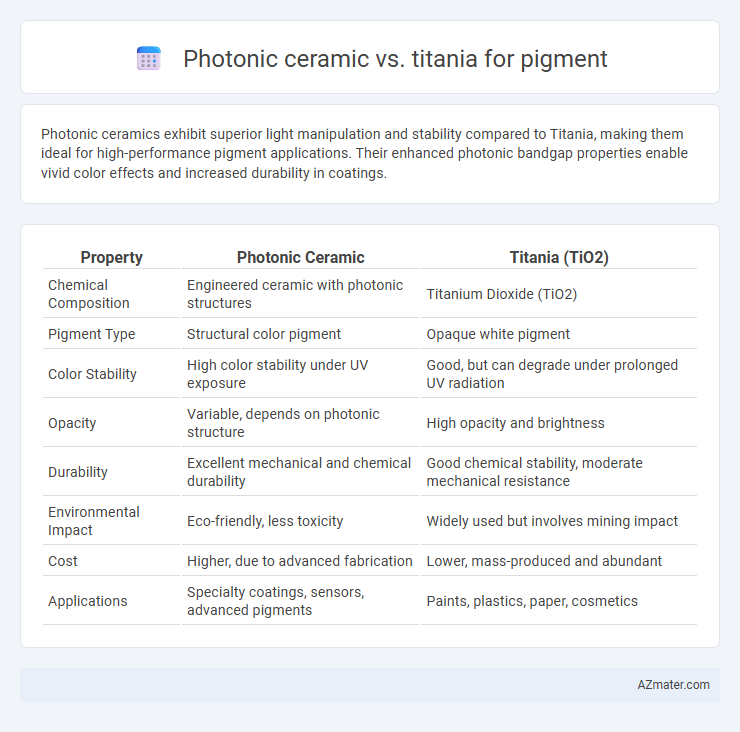Photonic ceramics exhibit superior light manipulation and stability compared to Titania, making them ideal for high-performance pigment applications. Their enhanced photonic bandgap properties enable vivid color effects and increased durability in coatings.
Table of Comparison
| Property | Photonic Ceramic | Titania (TiO2) |
|---|---|---|
| Chemical Composition | Engineered ceramic with photonic structures | Titanium Dioxide (TiO2) |
| Pigment Type | Structural color pigment | Opaque white pigment |
| Color Stability | High color stability under UV exposure | Good, but can degrade under prolonged UV radiation |
| Opacity | Variable, depends on photonic structure | High opacity and brightness |
| Durability | Excellent mechanical and chemical durability | Good chemical stability, moderate mechanical resistance |
| Environmental Impact | Eco-friendly, less toxicity | Widely used but involves mining impact |
| Cost | Higher, due to advanced fabrication | Lower, mass-produced and abundant |
| Applications | Specialty coatings, sensors, advanced pigments | Paints, plastics, paper, cosmetics |
Introduction to Photonic Ceramic and Titania Pigments
Photonic ceramics are advanced materials engineered to manipulate light through their precisely controlled microstructures, offering unique optical properties ideal for pigment applications. Titania pigments, primarily composed of titanium dioxide (TiO2), deliver high opacity and brightness, making them a dominant choice in paints and coatings for their excellent coverage and durability. While titania pigments rely on their high refractive index for scattering light, photonic ceramics utilize photonic bandgap effects to achieve vibrant coloration through structural color rather than chemical pigmentation.
Chemical Composition and Structure Comparison
Photonic ceramics typically consist of engineered dielectric materials with periodic nanostructures that manipulate light through photonic bandgap effects, enhancing coloration without relying on traditional pigments. Titania (titanium dioxide) pigments, composed mainly of TiO2 in anatase or rutile crystalline forms, exhibit strong light scattering due to their high refractive index and nanoscale particle size. While photonic ceramics rely on structural color generated by nanoscale architectures, titania pigments derive their whiteness and opacity chemically from their intrinsic crystal lattice and particle morphology.
Optical Properties: Color Brilliance and Opacity
Photonic ceramics exhibit superior color brilliance and enhanced opacity due to their highly ordered nanostructures that manipulate light through photonic bandgap effects, resulting in vivid, angle-dependent hues and deeper pigmentation. In contrast, titania (TiO2) provides strong opacity and brightness primarily through high refractive index and light scattering but offers more uniform, less vibrant color without structural coloration. The engineered nanoarchitecture in photonic ceramics outperforms titania pigments in applications demanding intense iridescence and tunable optical properties.
Environmental Sustainability and Toxicity
Photonic ceramics offer enhanced environmental sustainability over traditional titania pigments due to their reduced energy consumption during production and lower carbon footprint. Unlike titania, which can involve harmful mining practices and generate toxic waste, photonic ceramics utilize abundant, non-toxic materials, minimizing ecological impact. Their non-toxic properties also reduce risks to aquatic and human health, positioning photonic ceramics as a safer alternative for pigment applications.
Thermal and UV Stability
Photonic ceramics exhibit superior thermal stability compared to titania pigments, maintaining structural integrity at temperatures exceeding 1200degC, while titania typically degrades above 800degC. UV stability of photonic ceramics also surpasses that of titania, as photonic ceramics resist photodegradation and maintain color vibrancy after prolonged UV exposure. This makes photonic ceramics ideal for high-temperature coatings and UV-intensive applications where long-term durability is critical.
Performance in Industrial Applications
Photonic ceramics exhibit superior light manipulation properties and enhanced durability compared to titania, making them highly effective for advanced pigment applications in industrial settings. Titania remains popular due to its excellent opacity and cost-efficiency, but photonic ceramics offer improved color stability and resistance to environmental degradation in high-performance coatings and plastics. The choice between the two depends largely on application-specific requirements such as thermal stability, UV resistance, and the desired optical effects.
Manufacturing Processes and Costs
Photonic ceramic pigments are manufactured through advanced sintering and milling techniques that enable precise control over particle size and optical properties, resulting in higher material costs due to energy-intensive processes and specialized equipment. In contrast, titania pigments are produced using well-established sulfate or chloride processes, which offer cost-efficiency and scalability but with less control over photonic properties. The complexity and precision required in photonic ceramic manufacturing significantly increase production expenses compared to the mass-produced and economically favorable titania pigments.
Pigment Durability and Longevity
Photonic ceramics exhibit superior pigment durability compared to titania due to their enhanced resistance to UV degradation and chemical corrosion, ensuring prolonged color stability in harsh environmental conditions. Titania pigments can undergo photocatalytic reactions under UV exposure, leading to gradual color fading and reduced longevity. The inherent structural stability of photonic ceramics provides extended service life, making them ideal for applications demanding long-term pigment performance.
Advances in Pigment Technology
Photonic ceramics exhibit superior light manipulation properties compared to traditional titania pigments, enhancing color vibrancy and durability in advanced coating applications. Recent advances in pigment technology leverage the nanoscale structuring of photonic ceramics to achieve tunable optical effects and improved resistance to photodegradation. This innovation drives the development of pigments with higher brightness, energy efficiency, and environmental stability, outperforming conventional titania-based pigments.
Future Trends and Market Prospects
Photonic ceramics exhibit superior light manipulation capabilities compared to conventional Titania pigments, driving their adoption in advanced coatings and display technologies. Innovations in nanostructuring and doping techniques enhance photonic ceramic efficiency, positioning them for expanded use in sustainable and high-performance pigment applications. Market forecasts indicate robust growth fueled by increasing demand for eco-friendly and multifunctional pigments across automotive, aerospace, and consumer electronics industries.

Infographic: Photonic ceramic vs Titania for Pigment
 azmater.com
azmater.com